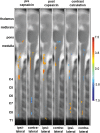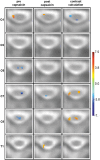Spinal fMRI reveals decreased descending inhibition during secondary mechanical hyperalgesia
- PMID: 25372292
- PMCID: PMC4221460
- DOI: 10.1371/journal.pone.0112325
Spinal fMRI reveals decreased descending inhibition during secondary mechanical hyperalgesia
Abstract
Mechanical hyperalgesia is one distressing symptom of neuropathic pain which is explained by central sensitization of the nociceptive system. This sensitization can be induced experimentally with the heat/capsaicin sensitization model. The aim was to investigate and compare spinal and supraspinal activation patterns of identical mechanical stimulation before and after sensitization using functional spinal magnetic resonance imaging (spinal fMRI). Sixteen healthy subjects (6 female, 10 male, mean age 27.2 ± 4.0 years) were investigated with mechanical stimulation of the C6 dermatome of the right forearm during spinal fMRI. Testing was always performed in the area outside of capsaicin application (i.e. area of secondary mechanical hyperalgesia). During slightly noxious mechanical stimulation before sensitization, activity was observed in ipsilateral dorsolateral pontine tegmentum (DLPT) which correlated with activity in ipsilateral spinal cord dorsal gray matter (dGM) suggesting activation of descending nociceptive inhibition. During secondary mechanical hyperalgesia, decreased activity was observed in bilateral DLPT, ipsilateral/midline rostral ventromedial medulla (RVM), and contralateral subnucleus reticularis dorsalis, which correlated with activity in ipsilateral dGM. Comparison of voxel-based activation patterns during mechanical stimulation before/after sensitization showed deactivations in RVM and activations in superficial ipsilateral dGM. This study revealed increased spinal activity and decreased activity in supraspinal centers involved in pain modulation (SRD, RVM, DLPT) during secondary mechanical hyperalgesia suggesting facilitation of nociception via decreased endogenous inhibition. Results should help prioritize approaches for further in vivo studies on pain processing and modulation in humans.
Conflict of interest statement
Figures





Similar articles
-
Spinal and supraspinal processing of thermal stimuli: an fMRI study.J Magn Reson Imaging. 2015 Apr;41(4):1046-55. doi: 10.1002/jmri.24627. Epub 2014 Apr 15. J Magn Reson Imaging. 2015. PMID: 24737401
-
Supraspinal modulation of neuronal synchronization by nociceptive stimulation induces an enduring reorganization of dorsal horn neuronal connectivity.J Physiol. 2018 May 1;596(9):1747-1776. doi: 10.1113/JP275228. Epub 2018 Mar 26. J Physiol. 2018. PMID: 29451306 Free PMC article.
-
Metabolic plasticity in the supraspinal pain modulating circuitry after noxious stimulus-induced spinal cord LTP.Pain. 2008 Dec;140(3):456-464. doi: 10.1016/j.pain.2008.09.029. Epub 2008 Nov 11. Pain. 2008. PMID: 19004552
-
Supraspinal contributions to hyperalgesia.Proc Natl Acad Sci U S A. 1999 Jul 6;96(14):7687-92. doi: 10.1073/pnas.96.14.7687. Proc Natl Acad Sci U S A. 1999. PMID: 10393881 Free PMC article. Review.
-
Diffuse noxious inhibitory controls (DNIC) in animals and in man.Patol Fiziol Eksp Ter. 1992 Jul-Aug;(4):55-65. Patol Fiziol Eksp Ter. 1992. PMID: 1303506 Review.
Cited by
-
The Neurophysiological Lesion: A Scoping Review.J Chiropr Med. 2023 Jun;22(2):123-130. doi: 10.1016/j.jcm.2022.09.002. Epub 2023 Apr 1. J Chiropr Med. 2023. PMID: 37346242 Free PMC article.
-
A comparison of the effectiveness of functional MRI analysis methods for pain research: The new normal.PLoS One. 2020 Dec 14;15(12):e0243723. doi: 10.1371/journal.pone.0243723. eCollection 2020. PLoS One. 2020. PMID: 33315886 Free PMC article.
-
Human surrogate models of central sensitization: A critical review and practical guide.Eur J Pain. 2021 Aug;25(7):1389-1428. doi: 10.1002/ejp.1768. Epub 2021 May 8. Eur J Pain. 2021. PMID: 33759294 Free PMC article.
-
Ten Key Insights into the Use of Spinal Cord fMRI.Brain Sci. 2018 Sep 10;8(9):173. doi: 10.3390/brainsci8090173. Brain Sci. 2018. PMID: 30201938 Free PMC article. Review.
-
Sensitization of the Nociceptive System in Complex Regional Pain Syndrome.PLoS One. 2016 May 5;11(5):e0154553. doi: 10.1371/journal.pone.0154553. eCollection 2016. PLoS One. 2016. PMID: 27149519 Free PMC article.
References
-
- Baron R, Binder A, Wasner G (2010) Neuropathic pain: diagnosis, pathophysiological mechanisms, and treatment. Lancet Neurol 9: 807–819. - PubMed
-
- Simone DA, Sorkin LS, Oh U, Chung JM, Owens C, et al. (1991) Neurogenic hyperalgesia: central neural correlates in responses of spinothalamic tract neurons. J Neurophysiol 66: 228–246. - PubMed
-
- Petersen KL, Rowbotham MC (1999) A new human experimental pain model: the heat/capsaicin sensitization model. Neuroreport 10: 1511–1516. - PubMed
-
- Villanueva L, Lopez-Avila A, Le Bars D (2006) Ascending nociceptive pathways. In: Cervero F, Jensen TS, editors. Handbook of Clinical Neurology, Vol 81 (3rd series): Pain. Amsterdam: Elsevier B.V. pp. 93–102. - PubMed
Publication types
MeSH terms
Substances
LinkOut - more resources
Full Text Sources
Other Literature Sources
Medical

